
Hakka, also rendered Kejia, is one of the major groups of varieties of Chinese, spoken natively by the Hakka people throughout southern China, Taiwan, Hong Kong, Macau and throughout the diaspora areas of East Asia, Southeast Asia, and in overseas Chinese communities around the world.

Guangdong is a province in South China, on the South China Sea coast. Guangdong surpassed Henan and Shandong to become the most populous province in China in January 2005, registering 79.1 million permanent residents and 31 million migrants who lived in the province for at least six months of the year; the total population was 104,303,132 in the 2010 census, accounting for 7.79 percent of Mainland China's population. This also makes it the most populous first-level administrative subdivision of any country outside of South Asia, as its population is surpassed only by those of the Pakistani province of Punjab and the Indian states of Bihar, Maharashtra and Uttar Pradesh. The provincial capital Guangzhou and economic hub Shenzhen are among the most populous and important cities in China. The population increase since the census has been modest, the province registering 108,500,000 people in 2015.
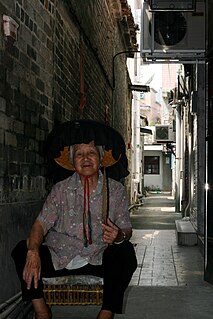
The Hakka, sometimes Hakka Han, are Han Chinese people whose ancestral homes are chiefly in the Hakka-speaking provincial areas of Guangdong, Fujian, Jiangxi, Guangxi, Sichuan, Hunan, Zhejiang, Hainan and Guizhou. The Chinese characters for Hakka (客家) literally mean "guest families". Unlike other Han Chinese groups, the Hakkas are not named after a geographical region, e.g. a province, county or city, in China. Modern day Hakka are generally identified by different degrees of Hakka ancestry and usually speak the Hakka language.

Hakka hill songs are rural songs sung in the Hakka language by the Hakka people. They are probably one of the better known elements that reflect Hakka culture, regarded by many as the 'pearl of Hakka Literature'.

Meizhou is a prefecture-level city in eastern Guangdong province, China. It has an area of 15,864.51 km2 (6,125.32 sq mi), and a population of 4.33 million at the 2010 census. It comprises Meijiang District, Meixian District, Xingning City and five counties. Its built-up or metro area made up of two districts was home to 935,516 inhabitants at the 2010 census.
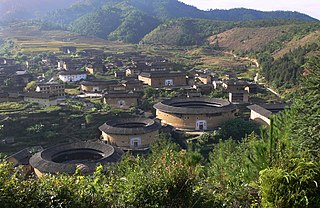
Longyan is a prefecture-level city in southwestern Fujian province, People's Republic of China, bordering Guangdong to the south and Jiangxi to the west.

Music of Guangdong is a synthesis of a number of local Guangdong folk music styles.

Jieyang is a prefecture-level city in Guangdong Province, People's Republic of China, part of the Chaoshan region whose people speak Teochew dialect distinct from neighbouring Yue speakers. It is historically important as the hometown of many overseas Chinese in Southeast Asia. It borders Shantou to the east, Chaozhou to the northeast, Meizhou to the north, Shanwei to the west, and looks out to the South China Sea to the south.

Jiangxi is a southeastern province of China. The area's musical heritage includes the Hakka music of Jiangzi, Fujian and Guangdong. Hakka music is literary and laid-back in tone, and consists entirely of five notes; many folk songs only use three notes.
Punti-Hakka Clan Wars or Hakka-Punti Clan Wars were a conflict between the Hakka and Cantonese people in Guangdong, China between 1855 and 1867. The wars were fierce around the Pearl River Delta, especially in Toi Shan of the Sze Yup counties. The wars resulted in roughly a million dead with many more fleeing for their lives.

Guangdong music, also known as Cantonese music is a style of traditional Chinese instrumental music from Guangzhou and surrounding areas in Pearl River Delta of Guangdong Province on the southern coast of China. The name of the music is not an accurate description because Guangdong music is not the only music of the whole Guangdong area. Cantonese classical music especially were usually much livelier in pace and happier than those of other China provinces which is typical and the very essence of the Cantonese's character. In Guangdong, there are numerous traditional genres of music such as Teochew music and Hakka music. The name of the music originated in the 1920 and 1930s when the music was popular in Shanghai ballrooms in the form of "Spiritual Music". As the performers were almost entirely from Guangdong, Shanghai people generalized the form of music as Guangdong music. Musically, compositions are based on tunes derived from Cantonese opera, together with new compositions from the 1920s onwards. Some pieces have influences from jazz and Western music, using syncopation and triple time, and incorporating instruments such as the saxophone, violin, guitar, piano, drum set, or xylophone.
Pha̍k-fa-sṳ is an orthography similar to Pe̍h-ōe-jī and used to write Hakka, a variety of Chinese. Hakka is a whole branch of Chinese, and Hakka dialects are not necessarily mutually intelligible with each other, considering the large geographical region. This article discusses a specific variety of Hakka. It was invented by the Presbyterian church in the 19th century. The Hakka New Testament published in 1924 is written in this system.

Pingyuan County is a county in the northeast of Guangdong Province, People's Republic of China. It is under the administration of Meizhou City.
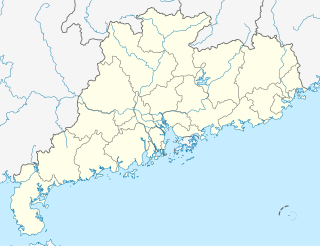
Qujiang is a district of Shaoguan, Guangdong province, China.

Shixing County is a county of Shaoguan, Guangdong province, China, bordering Jiangxi province to the east. The native variety of Chinese in the area is Hakka.
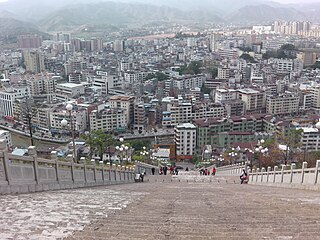
Heping is a county of northeastern Guangdong Province, China, bordering Jiangxi to the north. It is under the administration of Heyuan City. At the 2010 census, its population was around 300,000, with the majority of the residents being Hakka.
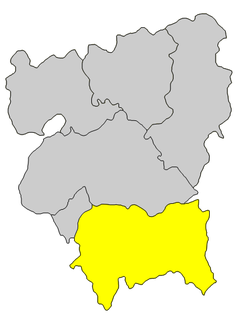
Zijin County is a county in the east of Guangdong Province, China. It is the southernmost county-level division of the prefecture-level city of Heyuan. The county was known as Yongan County before January 1914.

Jiexi County is a county of eastern Guangdong province, China. It is under the administration of Jieyang City.

Luhe County is a county of eastern Guangdong province, China. It is under the administration of Shanwei City. The majority of Luhe residents come from Hakka ancestry and speak a local dialect rooted in the Hakka language.
The Wuhua dialect is a major dialect of Hakka Chinese spoken in Wuhua County, Jiexi County, Shenzhen, eastern Dongguan, Northern Guangdong around Shaoguan, Sichuan Province, and Tonggu County in Jiangxi Province.















